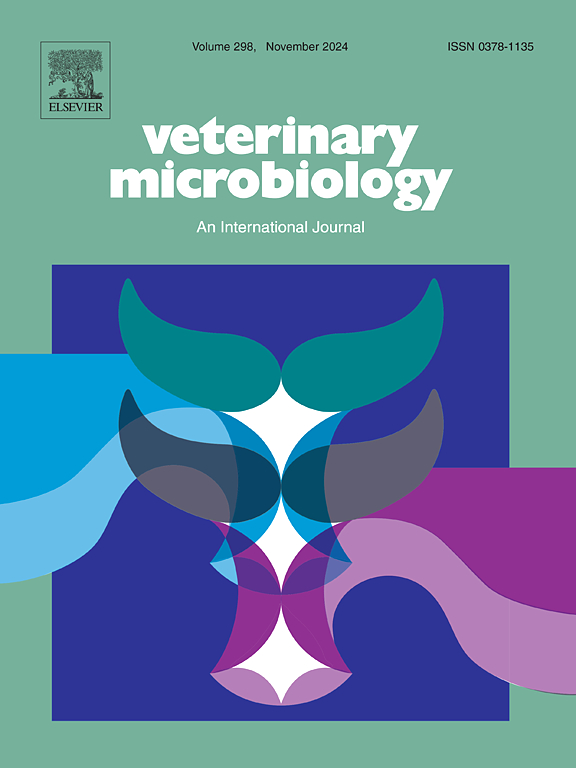The isolation and immunoprotective efficacy of outer membrane vesicles of Dichelobacter nodosus
IF 2.7
2区 农林科学
Q3 MICROBIOLOGY
引用次数: 0
Abstract
Dichelobacter nodosus is a major causative agent of infectious foot diseases in ruminants, responsible for substantial economic losses globally in the livestock industry. The development of a vaccine is therefore of great importance. In this study, we employed density gradient ultracentrifugation to extract outer membrane vesicles (OMVs) from D. nodosus and evaluated their immunoprotective effects. The extracted OMVs were spherical structures with an average diameter of 144 nm, predominantly comprising outer membrane proteins, toxin proteins, and lipoproteins, mainly involved in biological processes such as cellular protein metabolism and protein transmembrane transport. Mice immunized with OMVs showed significantly increased production of serum antigen-specific antibodies (P < 0.0001). In addition, compared with the control group, the expression of tumor necrosis factor-α, interferon-γ, and interleukin-1 in the serum of mice at 35 days post-immunization was significantly upregulated (P < 0.05). The protective efficacy of the vaccine was assessed by challenging with an intraperitoneal injection of 10 LD50 doses of D. nodosus, and the OMVs provided 100 % protection. Histopathological examination and tissue bacterial load detection revealed that the OMVs significantly alleviated tissue damage and bacterial colonization (P < 0.001). These findings provide a valuable reference and new strategies for the development of vaccines against D. nodosus to prevent infectious foot diseases.
结节双杆菌外膜囊泡的分离及免疫保护作用
结状双杆菌是反刍动物传染性足病的主要病原体,对全球畜牧业造成重大经济损失。因此,研制疫苗是非常重要的。在本研究中,我们采用密度梯度超离心法提取结节菌外膜囊泡(OMVs),并评价其免疫保护作用。提取的omv为平均直径144 nm的球形结构,主要由外膜蛋白、毒素蛋白和脂蛋白组成,主要参与细胞蛋白质代谢和蛋白质跨膜运输等生物过程。经omv免疫的小鼠血清抗原特异性抗体的产生显著增加(P <; 0.0001)。此外,与对照组相比,免疫后35 d小鼠血清中肿瘤坏死因子-α、干扰素-γ和白细胞介素-1的表达显著上调(P <; 0.05)。通过腹腔注射10 LD50剂量的结节性弓形虫来评估疫苗的保护效果,omv提供了100% %的保护。组织病理学检查和组织细菌负荷检测显示,omv显著减轻了组织损伤和细菌定植(P <; 0.001)。这些发现为开发结节曲菌疫苗预防传染性足病提供了有价值的参考和新策略。
本文章由计算机程序翻译,如有差异,请以英文原文为准。
求助全文
约1分钟内获得全文
求助全文
来源期刊

Veterinary microbiology
农林科学-兽医学
CiteScore
5.90
自引率
6.10%
发文量
221
审稿时长
52 days
期刊介绍:
Veterinary Microbiology is concerned with microbial (bacterial, fungal, viral) diseases of domesticated vertebrate animals (livestock, companion animals, fur-bearing animals, game, poultry, fish) that supply food, other useful products or companionship. In addition, Microbial diseases of wild animals living in captivity, or as members of the feral fauna will also be considered if the infections are of interest because of their interrelation with humans (zoonoses) and/or domestic animals. Studies of antimicrobial resistance are also included, provided that the results represent a substantial advance in knowledge. Authors are strongly encouraged to read - prior to submission - the Editorials (''Scope or cope'' and ''Scope or cope II'') published previously in the journal. The Editors reserve the right to suggest submission to another journal for those papers which they feel would be more appropriate for consideration by that journal.
Original research papers of high quality and novelty on aspects of control, host response, molecular biology, pathogenesis, prevention, and treatment of microbial diseases of animals are published. Papers dealing primarily with immunology, epidemiology, molecular biology and antiviral or microbial agents will only be considered if they demonstrate a clear impact on a disease. Papers focusing solely on diagnostic techniques (such as another PCR protocol or ELISA) will not be published - focus should be on a microorganism and not on a particular technique. Papers only reporting microbial sequences, transcriptomics data, or proteomics data will not be considered unless the results represent a substantial advance in knowledge.
Drug trial papers will be considered if they have general application or significance. Papers on the identification of microorganisms will also be considered, but detailed taxonomic studies do not fall within the scope of the journal. Case reports will not be published, unless they have general application or contain novel aspects. Papers of geographically limited interest, which repeat what had been established elsewhere will not be considered. The readership of the journal is global.
 求助内容:
求助内容: 应助结果提醒方式:
应助结果提醒方式:


